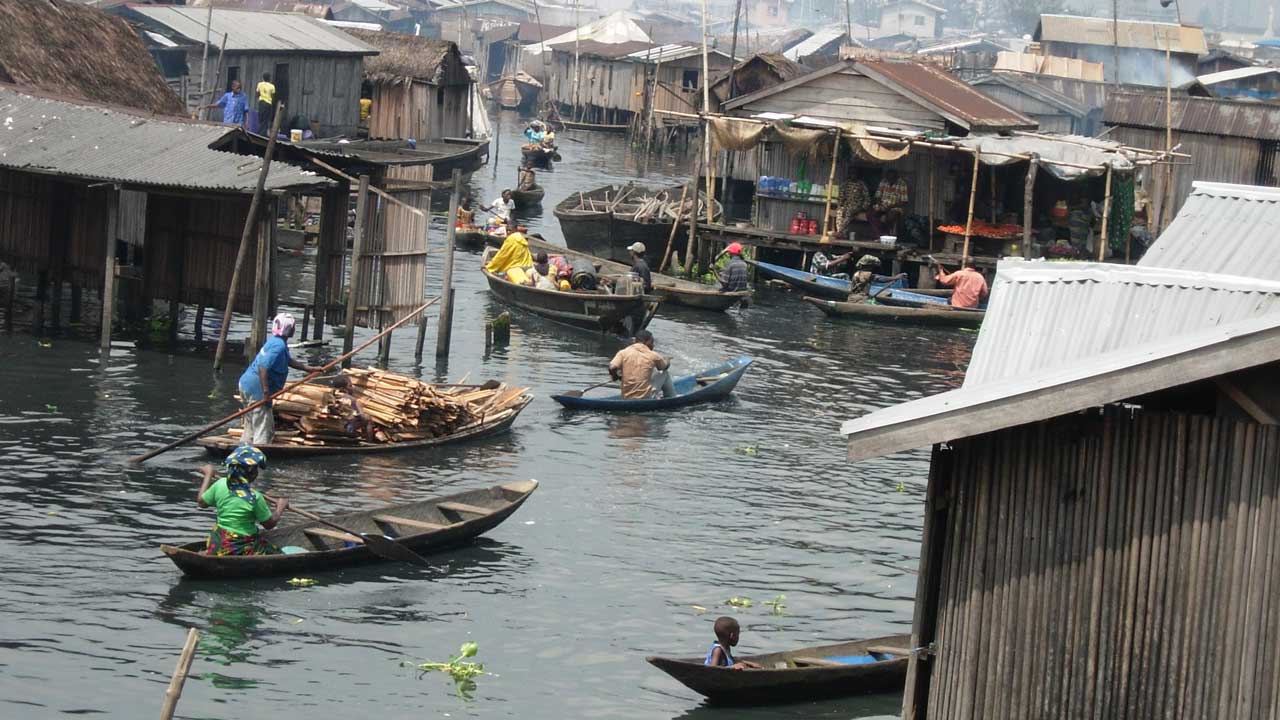
Major cities are experiencing rapid urbanisation than its infrastructure development can match for decent living, Victor Gbonegun reports.
Urbanisation pattern, trend, and characteristics have been alarming due to insecurity and search for better living standards. The towns and cities have grown with pace showing high rates of five to10 per cent yearly.
This has created crises of potable water supply, squalor and shanty settlements, sanitation, solid waste management, double burden of diseases and inefficient, congested, and risky transport system.
The UN-Habitat World Cities Report 2022 predicted that the world would continue to urbanise over the next three decades from 56 per cent in 2021 to 68 per cent in 2050.
This, the report says translates into an increase of 2.2 billion urban residents, living mostly in Africa and Asia. It stated that the worst-case scenario of urban futures is that extreme poverty could increase by 32 per cent or 213 million by 2030.
The report noted that low-income countries like Nigeria have much higher absolute and relative city population growth than higher income countries, adding that from 1975 to 2020, their city population grew fourfold to about 300 million.
The UN agency projections also show that, between 2020 and 2070, the number of cities in low-income countries will grow far more than in the rest of the world – an increase of 76 per cent, compared to six per cent in upper-middle-income countries, while high-income and lower-middle-income countries will see an increase of about 20 per cent.
The World Bank estimated that 56 per cent of the world’s population, which is approximately 4.4 billion inhabitants, now lives in cities. This trend, it stated, is expected to continue with the urban population more than doubling its current size by 2050, at which point nearly seven of 10 people will live in cities.
Currently, Nigeria continues to grow from a population of 45.1 million in 1960 to an estimated 221 million and is predicted to reach 264 million by 2030. Over the past three decades, the population in Nigeria’s urban areas increased five-fold, particularly in Lagos and Abuja, considered as rich in economic prospects and safe.
Lagos State, previously seven million in 2020, is now projected to be over 15 million, while Port Harcourt, the oil and gas capital of Nigeria with one million populations in 2,000 now projected to be over 3.4 million.
With a yearly urban population growth rate of 4.3 per cent, Lagos, Abuja, Kano, Ibadan, Port Harcourt and others are struggling with migration-induced challenges that include insecurity, unsustainable housing, waste management, unemployment, lack of cheap, safe and reliable mobility and road networks that are stretched well-beyond capacity.
Lagos and Abuja have so far recorded over 1,000 per cent increases in population. Lagos population rose from less than one million in 1963 to over four million in 1982 to the present 20 million people.
Figures from the 2006 National Population census revealed that Oyo, which has 5,580,894 people is estimated at over 12 million people as of 2023 and Kano with 9,401,288 is estimated to have 20 million as of 2023.
The 2006 figure further shows that Abuja has 1,406,239 people but currently hosts over 3,839,646 people, while Rivers state, which had 5,198,716 is estimated to have about 7,476,800.
Essentially, most of these migrations are from crisis prone areas to cities described as more secured, which has led to large-scale population increase in Lagos and Abuja. These cities relatively reflect largely the federal character and accommodating different ethnic groups across the country. In the last 20 years the two cities have become the primary destination for migrants, who are fleeing from one crisis or the other in their respective states.
In recent times, Nigeria has faced an unprecedented wave of overlapping security crises ranging from kidnapping to insurgencies in every part of the country, which has forced many to relocate to safer city centres. Lagos for instance, has since 2016 witnessed increases with a daily influx of 123,840 people, a large percentage of this number come to the state to seek economic opportunities.
The housing need of Lagos is within the range of more than two million housing units, while the rate of production projected to meet the number on yearly basis is 200,000 housing units but the rate of production is at 1, 000 to 1,500 housing units per year, which is a far cry from what is needed.
The housing developers struggle to meet different needs of the population to keep up supply; hence there have been a lot of non-standardised buildings coming into the market on a regular basis, thereby worsening record cases of collapsed buildings.
Findings revealed that most migrants into the city are vulnerable economically, lacked enough funds and resources to seek standard accommodation and prefer houses in substandard, informal and slum settlements. The implication of this, according to experts, is proliferation of slum communities and more informal settlements.
In the transportation sector, Lagos is still dealing with less than 35 km length of rail service, whereas by standard, there should be over 10,000 km of rail length to deal with the transportation needs. In the water sector, the city of Lagos largely depends on borehole, which implies that the rate at which borehole is sung will be higher, the same thing with water requirement for population.
The city is already dealing with waste management issues. Despite enrolment of private sector operators, wastes are dumped into water channels, drainages are clogged and preventing free flow of water, as the problem remains unresolved. More people thus, means more impact on waste management, water channels and systems.
Climate change is also impacting the city with rising sea level in a coastal city affecting the flow of water, worsening flooding, destroying life and property. Amid these deficits, an additional influx of migrants joining already over stretched infrastructure is like a time bomb.
For Abuja, the administrative capital of Nigeria, which was originally planned for three million people, the population has grown beyond that figure. The infrastructure provision made to accommodate that population, less than 50 per cent of it based on the master plan of Abuja has been met. In the area of transportation and network systems, the various modes of transportation are yet to be built up to 10 per cent.
The mass transit system is still at low ebb. The ring road is still about 30 to 40 per cent complete. Influx of people in Abuja areas put pressure on existing taxi systems, tricycles and areas where motorcycles are allowed. Also the water and wastewater management system in certain parts of the city, originally designed for one million people have become overstretched beyond the number, hence the collapse of infrastructure within Abuja.
The United Nations Deputy Secretary-General, Amina Mohammed, said for African cities to play their role as ‘heartbeats’ of trade and investments, adequate infrastructure and facilities must be created to attract investors, including in the fields of energy, transport, housing, communications, industrial and agricultural production.
Experts say adopting tools such as master plans can help identify and prioritise interventions, including reducing infrastructure gap in cities. NITP President, Nathaniel Atebije, observed that once there is rapid urbanisation, the only way that government and people can cope and manage it is through planning, adding that without planning, people will build illegally, which will create more serious problems, hence slums will be created and criminality will be high.
He said: “Most of the time, government looks for ad-hoc solutions to a problem that will stay with you for life. Rapid urbanisation requires efficient planning and adequate human habitation. It is an opportunity for planning and providing more jobs for town planners and good accommodation for the people, who have migrated to cities.”
First Vice President, Nigerian Institute of Town Planners (NITP), Mr. Chime Ogbonna, expressed concern that the nation continue to allow people to move to the cities, when there are no arrangement for them regarding housing, energy consumption, agriculture production and other basic infrastructure to inhabit the new area, but for the fact that few industries are located in the city.
He said this often poses several challenges, including increase crimes and criminality in the cities and other anti-social behaviour, saying, “Once a city has a high rate of unemployment, the next thing that follows is criminality and such a society will have no future.”
Ogbonna said: “When people begin to gather and no plan was made ab-initio to accommodate them, what you find is chaos and that is what you find everywhere in Nigeria. In advanced countries, they determine ahead of time that people would leave a particular location for another and facilities that will be needed and employment opportunities.”
NITP past president, Luka Achi, said governments, as the highest spender in any society, has to wake up and fulfill their basic roles, which include providing infrastructure faster because population keeps increasing at rapid rate.
He said government needs to improve the standard of various settlements across the country at both rural and urban locations through medium, short and long-term plans.
“The issue of creating more jobs is also crucial by making certain sectors more attractive to young persons and promoting small and medium scale industries for individuals to establish themselves, which diverts people’s attention to stay in rural areas.
“Town planners should also advise government on the best way to accommodate changes that are taking place, proffer the best sites for people to live, otherwise urban sprawl will develop,” Achi said.
An expert and urban planner, Mr. Lookman Oshodi, said majority of areas around Abuja has seen rapid growth of slums and informal settlements due to higher influx of people into the city. According to him, the growth is faster and more than what can be regarded as formal development.
“In the past, certain areas of Abuja in terms of development were reserved for free flow of water, green areas, landscape with remarkable land layout but unfortunately because of rapid rate of urbanisation, those places have been encroached upon and flooding is taking place in different locations. This includes original settlement areas like Durumi, Mpape and others. With more people, there is impact on the land use and development patterns.”
Oshodi said with the development; an average of 10 to 15 per cent rapid rate of informal settlements’ proliferation is projected in Abuja and others. He said: “By the time we look at what happened this year in terms of development and get back to such locations in another year, one would have seen a substantial leap in terms of where we were last year and this year. That means there is a lot of development pressure on Abuja and how will Abuja cope?
“The case of Abuja is precarious because apart from the people running away from insecurity, Abuja is closer to the Northern part of the country and a major stop point for many before migrating to the Southern part of the country. Abuja is a home to politicians, some of the migrants were brought to Abuja to protest and some of them stayed back adding to the development pressure.”
While suggesting physical solutions to the challenges posed by rapid urbanisation, Oshodi said, the crisis forcing many people to migrate to cities should be nipped in the bud by addressing the economic realities of the country, especially poverty and insecurity.
“There should be some level of equity and justice in addressing how resources are distributed among different stakeholders to retain people in their original place of settlement.
“The government should embark on physical planning, development and infrastructure delivery, as well as resettlement action plans for key cities in Nigeria. The city needs to plan beyond the traditional planning approach of planning for people, who are within the city.
“We will keep expecting that more people will come. Even if they don’t come, we have to put them in the plan that at a certain time, we are expecting, for instance 10,000 people and continue to update plans and accommodate the influx of people,” Oshodi said.
He further emphasised the need for resettlement plan as key tool to begin process of integration in terms of housing requirement, what part of the city will the people be accommodated in a sustainable manner and housing plans. He added that to achieve this objective, professional urban planners and city system experts must be involved to offer solutions to government and advice on how to implement such schemes.






